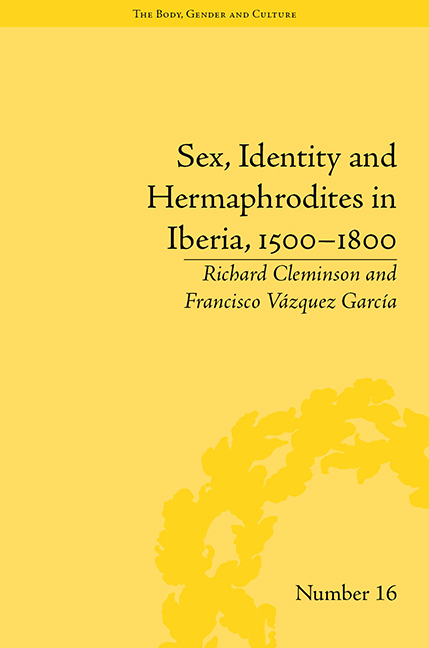Book contents
- Frontmatter
- CONTENTS
- Acknowledgements
- Introduction: Sex, Gender and Historicity
- 1 Marvels, Monsters and Prodigies: Hermaphrodites as Natural Phenomena in Spain, 1500–1700
- 2 Sexual Transgression and Hermaphroditism: The ‘New World’ and Imperial Subjectivity
- 3 The Expulsion of the Marvellous: The Decline of the ‘One-Sex’ Model, 1750–1830
- 4 Hermaphroditism in Portugal
- Conclusion
- Notes
- Works Cited
- Index
Introduction: Sex, Gender and Historicity
- Frontmatter
- CONTENTS
- Acknowledgements
- Introduction: Sex, Gender and Historicity
- 1 Marvels, Monsters and Prodigies: Hermaphrodites as Natural Phenomena in Spain, 1500–1700
- 2 Sexual Transgression and Hermaphroditism: The ‘New World’ and Imperial Subjectivity
- 3 The Expulsion of the Marvellous: The Decline of the ‘One-Sex’ Model, 1750–1830
- 4 Hermaphroditism in Portugal
- Conclusion
- Notes
- Works Cited
- Index
Summary
In a short article published in 1928 in the highly specialist medico-legal journal Archivo de Medicina Legal, the forensic doctor Asdrúbal António de Aguiar provided what was one of the first overviews on hermaphroditism in early twentieth-century Portuguese medical circles. De Aguiar's discussion and reproduction of documentation relevant to a long-lost case of suspected hermaphroditism from 1622 at the Convent of Santa Cruz in the small Alentejo town of Vila Viçosa was preceded by a historical and diagnostic framework that would structure the author's future work on this and related subjects pertaining to sexual matters. That this was a relatively unexplored area of Portuguese history and legal medicine was emphasized by de Aguiar – he noted that ‘Não abundam em Portugal alusões a antigos casos de hermafroditismo’ (There is not an abundance of allusions in Portugal to historical cases of hermaphroditism) – and despite some other studies from the 1920s and 1930s, until recently this lack of attention has prevailed. The state of historiography in respect of studies on hermaphroditism and sex change in Spain, by contrast, is more advanced, not only in terms of historical cultural analysis, for example on the subject of ‘gender subversion’ in Golden Age literature and theatre, but also in terms of specific studies on dissident figures such as Catalina de Erauso; but comparative research into hermaphroditism in Iberia is in its infancy.
- Type
- Chapter
- Information
- Publisher: Pickering & ChattoFirst published in: 2014



